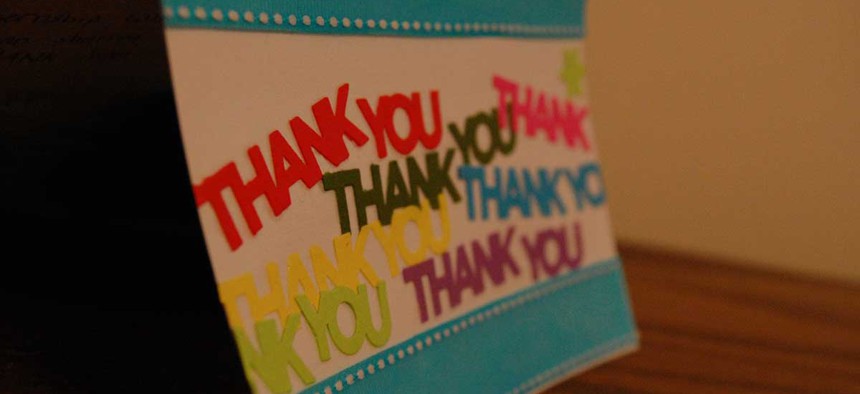There’s a Simple Way to Have Meetings That Result in Something Meaningful
Gratitude unlocks something in all of us.
Earlier this summer, I attended a meeting at the White House hosted by Stanford Medicine X and the Office of Science and Technology Policy (OSTP). The daylong workshop had a wide range of attendees, from Pfizer and Apple executives to patients researching their own fatal illnesses. The group of 90 was tasked with developing ways to engage doctors, scientists, policy makers, developers, families, and patients in research.
For such a complex problem, a single day seemed hardly sufficient to leave with concrete ways to tackle the problem. But Claudia Williams, a senior policy advisor for OSTP and one of the leaders of the workshop, did something ingenious as the meeting came to a close. She set aside time for everyone in the room to share an appreciation, extend an offer, or make an ask. People raised their hands and spoke ad-hoc. No one had anything prepared but a few people expressed gratitude, some made asks, and many more put forth offers.
The appreciation comes first and it’s really the key to the whole exercise. It can be anything ranging from thanking the organizers for hosting the meeting to offering gratitude to a specific individual for taking the lead on an agenda item.
Nick Dawson, the executive director of Johns Hopkins Sibley Innovation Hub and an executive board member of Medicine X who’s hosted workshops with Williams, said: “Claudia, in particular, has always done this moment of appreciation at the end and I think it does this thing where it unlocks people. It makes them willing to talk about what they have to offer. As soon as somebody starts to feel that there’s appreciation in the room, it becomes a very safe place to share things. I’ve seen it be really effective.”
After people started sharing their appreciation at the event, the offers came pouring in, so many that someone started writing them with a marker on a giant easel pad.
I wondered if this would work for as few as five people or a group larger than 90. Dawson said, “I think the bigger the room the harder the first couple are because people are afraid to speak in large groups. I’ve got the sense it’d be pretty hard to top out and I think it’s addicting. It’s one of those things like giving a present; it feels better to give a gift than get it.”
Williams said she’d started doing the appreciation piece when she was leading a team at the Department of Health and Human Services. “Often particular things get celebrated on a team, usually really public and really big, and a lot of things came behind those accomplishments,” she said. “I found there were things I didn’t know or others didn’t know had happened. It was a way to recognize everyone’s contributions.”
The workshop I attended involved brief presentations, but the majority of the day was spent solving specific problems and interacting with other attendees. I could see the method being used at a conference or a networking event where the goal is to have participants leave having made new connections. It might also be used at a company for a group of people that don’t often interact with each other but should, or it might serve as a tool for a post-mortem after a new initiative has been launched.
This is a really effective and powerful way to build connections and facilitate action. Williams said, “I started using it in more public settings over the last year, and at first I was not sure it would have the intimacy and serve the same purpose. But I find it extends the relationships beyond the event and is a beautiful way to close.”
It’s not your job to manage the outcomes, only to set participants on a path to develop a relationship that might turn into a collaboration. Williams credits Keith McCandless, co-founder of Social Invention Group, who’s developed a set of rules for promoting openness at group meetings, with that principle.
As the Power Moves series reveals, some of the best practices in management come from unexpected places—like a health-care meeting at the Eisenhower Executive Building next to the White House.
(Image via Flickr user Minda Haas Kuhlmann)



